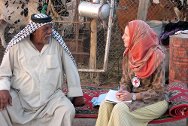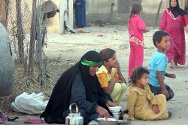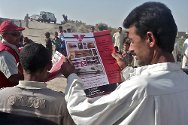Iraq: clearing bombs to make the countryside safe for livestock and children
23-11-2010 Feature
When the guns fall silent, civilians often face a stark choice: farm on land littered with unexploded shells or go hungry. ICRC weapon contamination experts recently cleared unexploded munitions from a village north-west of Basra, southern Iraq. One of the families talked to us about life with eight small children and a field full of bombs.
Haji Jassim Mohammed Asmar (63) is from Amara in southern Iraq. He and his extended family moved to Kesra in 2003 and settled in a house a few kilometres outside the village. The extended family consists of Haji Jassim, his wife, three of their grown-up children (a son and two daughters) and his eight young grandchildren. One of his daughters lost her husband during the war and moved back home with her three children, while his other daughter was nine months pregnant when the ICRC met her in October 2010. Jassim's other son is detained in Missan.
"We live a very simple life, but it's still a struggle to make ends meet," explains Jassim. The house has no water, and they pay about 5,000 Iraqi dinars (about $4) for a week's supply. "We knew that there were unexploded munitions in the ground before we moved in, but we had no choice. We tried to bury the ones we found, and we knew how to defuse some of them. Doing it ourselves was a risk, but no one in our family was ever injured, thank God. I didn't let the children play there – they had to stay close to the house, out of the fields."
ICRC weapon contamination experts assessed the area in June and started clearance work shortly after. Four days later, the team declared the family field safe, having removed 118 unexploded shells and bombs.
Getting the field cleared has made a big difference to family life. "The ICRC has taken a huge weight off our shoulders. When I told them that we used to defuse some of the devices ourselves, they said we'd been taking a huge risk. They showed us how dangerous these things were, and I realised we were lucky not to have blown ourselves up!"
Haji Jassim smiles at the children running around. "Now these things are gone, my grandchildren can play in the field, and I feel a lot more relaxed when we take the sheep out to graze." He goes on: "The ICRC really has to do the same thing for other people, because these weapons can cause so much suffering. Families just want to know that their children and livestock will come back from their own fields in one piece."




